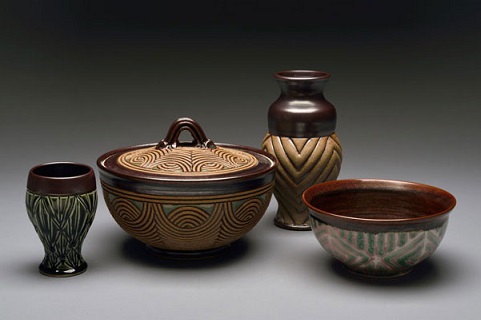
 David MacDonald, Professor Emeritus of Ceramics at Syracuse University, grew up in Hackensack, New Jersey, in the 1950s and ’60s as the third eldest of nine children. He was captain of his highschool track and cross country teams, setting school records in the one-mile race. He obtained an athletic scholarship to Hampton Institute (now Hampton University) in Tidewater, Virginia, and graduated in 1968 as an art education major.
David MacDonald, Professor Emeritus of Ceramics at Syracuse University, grew up in Hackensack, New Jersey, in the 1950s and ’60s as the third eldest of nine children. He was captain of his highschool track and cross country teams, setting school records in the one-mile race. He obtained an athletic scholarship to Hampton Institute (now Hampton University) in Tidewater, Virginia, and graduated in 1968 as an art education major.
Joseph W. Gilliard (1914–2004) served as his undergraduate mentor in ceramics at Hampton during those socially turbulent times. He spent an extra year at Hampton developing his MFA application portfolio, then attended the University of Massachusetts, Amherst, for a semester before he was actively recruited by Robert “Bob” Stull (1935–1994) to attend the MFA program in ceramics at the University of Michigan in Ann Arbor.
Both Joseph W. Gilliard and Robert “Bob” J. Stull, had a deep, lasting impact on MacDonald’s life and work as a potter, teacher, and person. Not only were Gilliard and Stull role models as ceramic artists, craftsmen, and educators, but they were also black. For the young African-American MacDonald, this must have seemed like a godsend.
Gilliard was a consummate craftsman and an extraordinary teacher. As MacDonald describes it, Gilliard was like a grandfather to him. Gilliard, also a metalsmith, was continuously interested in the technical side of ceramics, successfully formulating a variety of sought-after clay bodies and glazes.
Looking back at his beginnings, MacDonald realized that pottery struck a responsive chord in his psyche when he took a ceramics class as a requirement to become an art educator. He was intrigued and skeptical about being able to make something he could actually use. It was a pivotal moment, which set the direction for the rest of his career.
At Hampton, MacDonald didn’t just fall in love with making pottery; he consciously decided to commit his life to working in ceramics. Thereafter, he practically lived in the clay studio day and night as an undergraduate. According to MacDonald, Gilliard would frequently say this about clay: “You can take this material that has no intrinsic value and turn it into something which is not only beautiful but also useful.” As MacDonald explains, “That whole notion of utility has been a driving force in my work. When people call me a ceramist or ceramic artist, I reply that I am a potter. My work centers on the notion of the vessel and the type of human connections people develop personally and culturally around vessels.”



